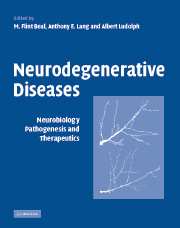Book contents
- Frontmatter
- Contents
- List of contributors
- Preface
- Part I Basic aspects of neurodegeneration
- Part II Neuroimaging in neurodegeneration
- Part III Therapeutic approaches in neurodegeneration
- Normal aging
- Part IV Alzheimer's disease
- 27 Mild cognitive impairment
- 28 Alzheimer's disease: overview
- 29 The neuropathology of Alzheimer's disease in the year 2005
- 30 Genetics of Alzheimer's disease
- 31 The role of ß-amyloid in Alzheimer's disease
- 32 Treatment of Alzheimer's disease
- Part VI Other Dementias
- Part VII Parkinson's and related movement disorders
- Part VIII Cerebellar degenerations
- Part IX Motor neuron diseases
- Part X Other neurodegenerative diseases
- Index
- References
31 - The role of ß-amyloid in Alzheimer's disease
from Part IV - Alzheimer's disease
Published online by Cambridge University Press: 04 August 2010
- Frontmatter
- Contents
- List of contributors
- Preface
- Part I Basic aspects of neurodegeneration
- Part II Neuroimaging in neurodegeneration
- Part III Therapeutic approaches in neurodegeneration
- Normal aging
- Part IV Alzheimer's disease
- 27 Mild cognitive impairment
- 28 Alzheimer's disease: overview
- 29 The neuropathology of Alzheimer's disease in the year 2005
- 30 Genetics of Alzheimer's disease
- 31 The role of ß-amyloid in Alzheimer's disease
- 32 Treatment of Alzheimer's disease
- Part VI Other Dementias
- Part VII Parkinson's and related movement disorders
- Part VIII Cerebellar degenerations
- Part IX Motor neuron diseases
- Part X Other neurodegenerative diseases
- Index
- References
Summary
Introduction
ß-Amyloid is a central element of the histopathology of Alzheimer's disease. It damages neurons and it causes the formation of neurofibrillary tangles. It is genetically linked to mutations that cause familial Alzheimer's disease, and it is associated with polymorphisms that increase the risk for developing Alzheimer's disease. ß-Amyloid can be imaged by positron emission tomography in living people, and it is a major therapeutic target for the development of disease-modifying therapies (Selkoe, 2004).
ß-amyloid plaques are major histophathological hallmarks of Alzheimer's disease
The neuropathological diagnosis of Alzheimer's disease is based upon the presence in brain of ß-amyloid plaques and neurofibrillary tangles (Duyckaerts & Dickson, 2003). ß-Amyloid deposits occur within the neuropil in several forms depending upon the degree of aggregation and fibrillization of the amyloid ß-peptides Aß40 and Aß42, their principal proteinaceous components. The two most abundant, albeit different, forms of amyloid plaques are neuritic ß-amyloid plaques and diffuse plaques. Neuritic, or “senile,” ß-amyloid plaques occur rarely in healthy subjects, they are an early histopathological sign of Alzheimer's disease (Tiraboschi et al., 2004). Neuritic ß-amyloid plaques are composed of higher-order ß-amyloid fibrils that can be detected by Thioflavin S or Congo red, as well as by silver-based stains and by immunohistochemistry. Amyloid fibrils within the cores of neuritic ß-amyloid plaques visualized by electron microscopy have diameters of upto 10 nm, and often occur in radiating, star-like assemblies.
- Type
- Chapter
- Information
- Neurodegenerative DiseasesNeurobiology, Pathogenesis and Therapeutics, pp. 452 - 458Publisher: Cambridge University PressPrint publication year: 2005

